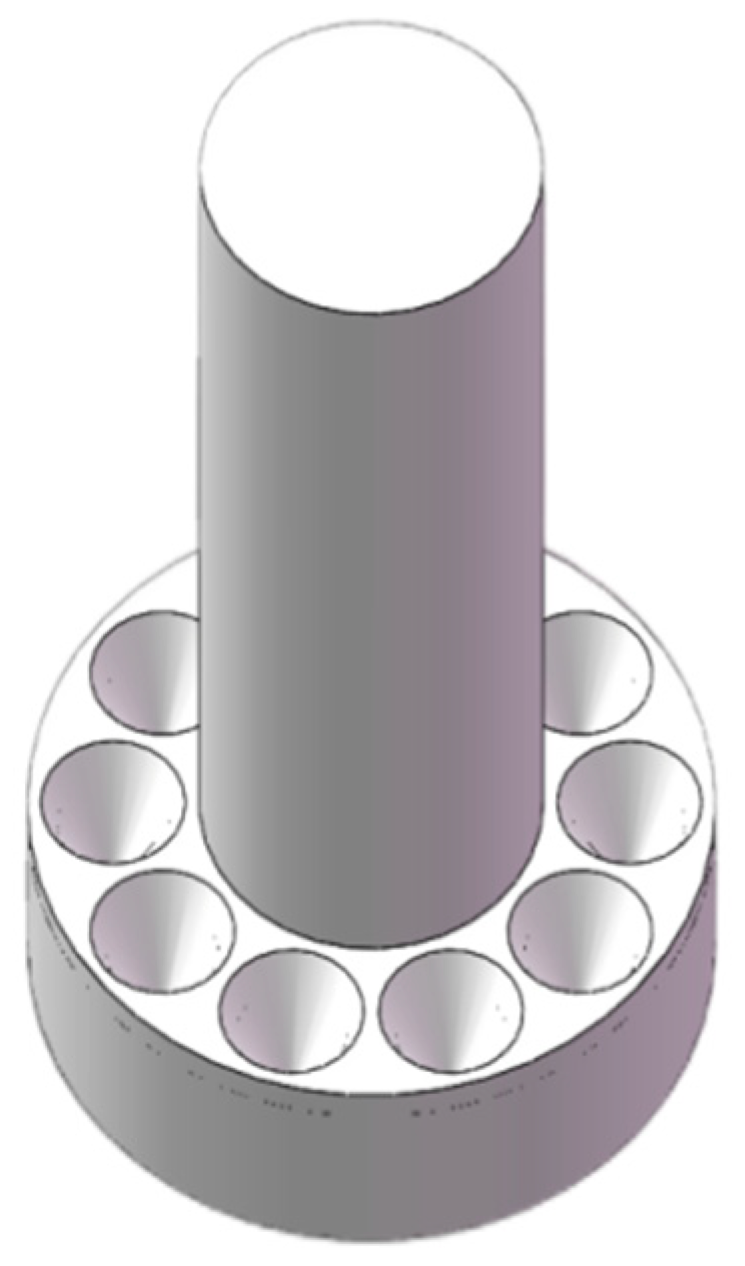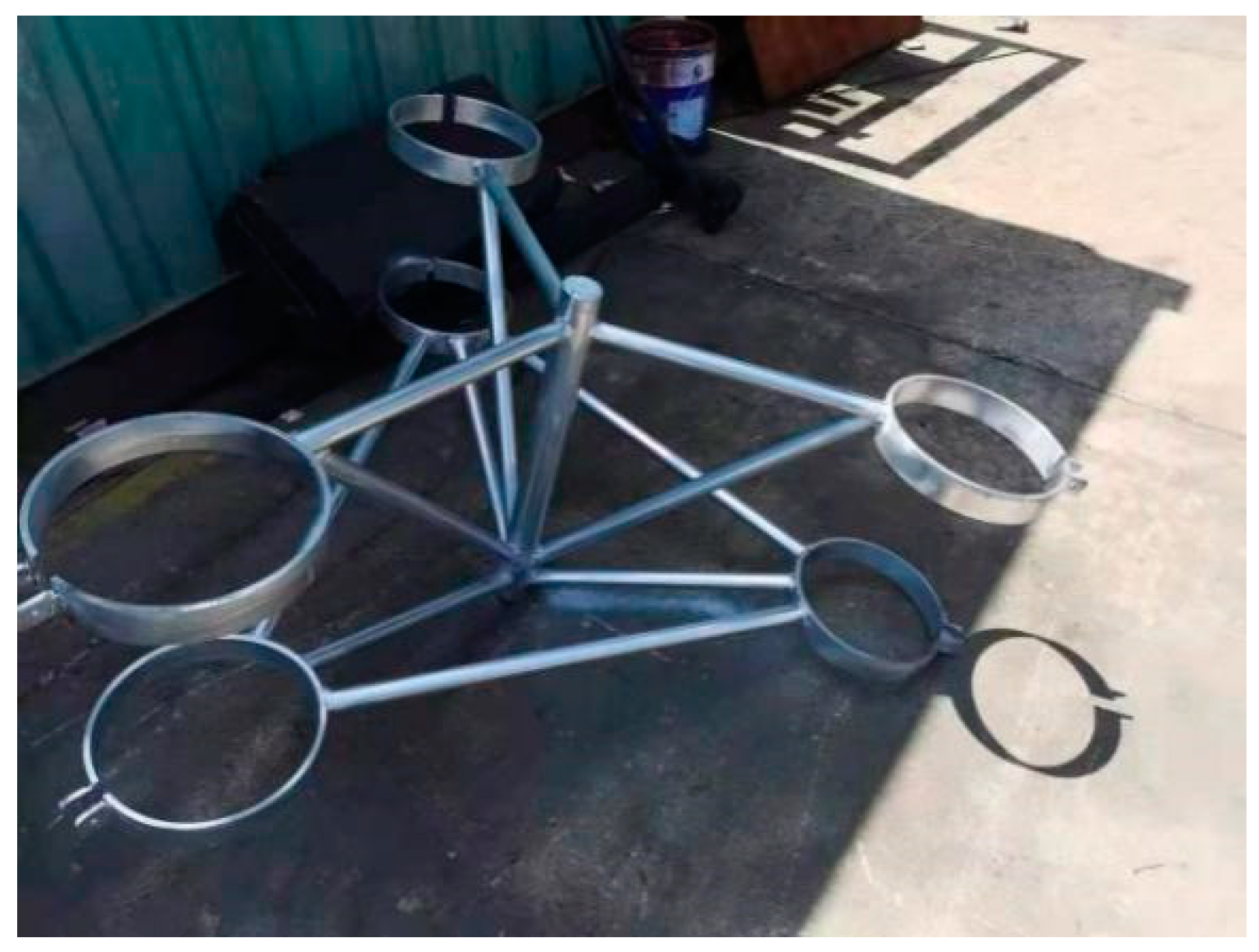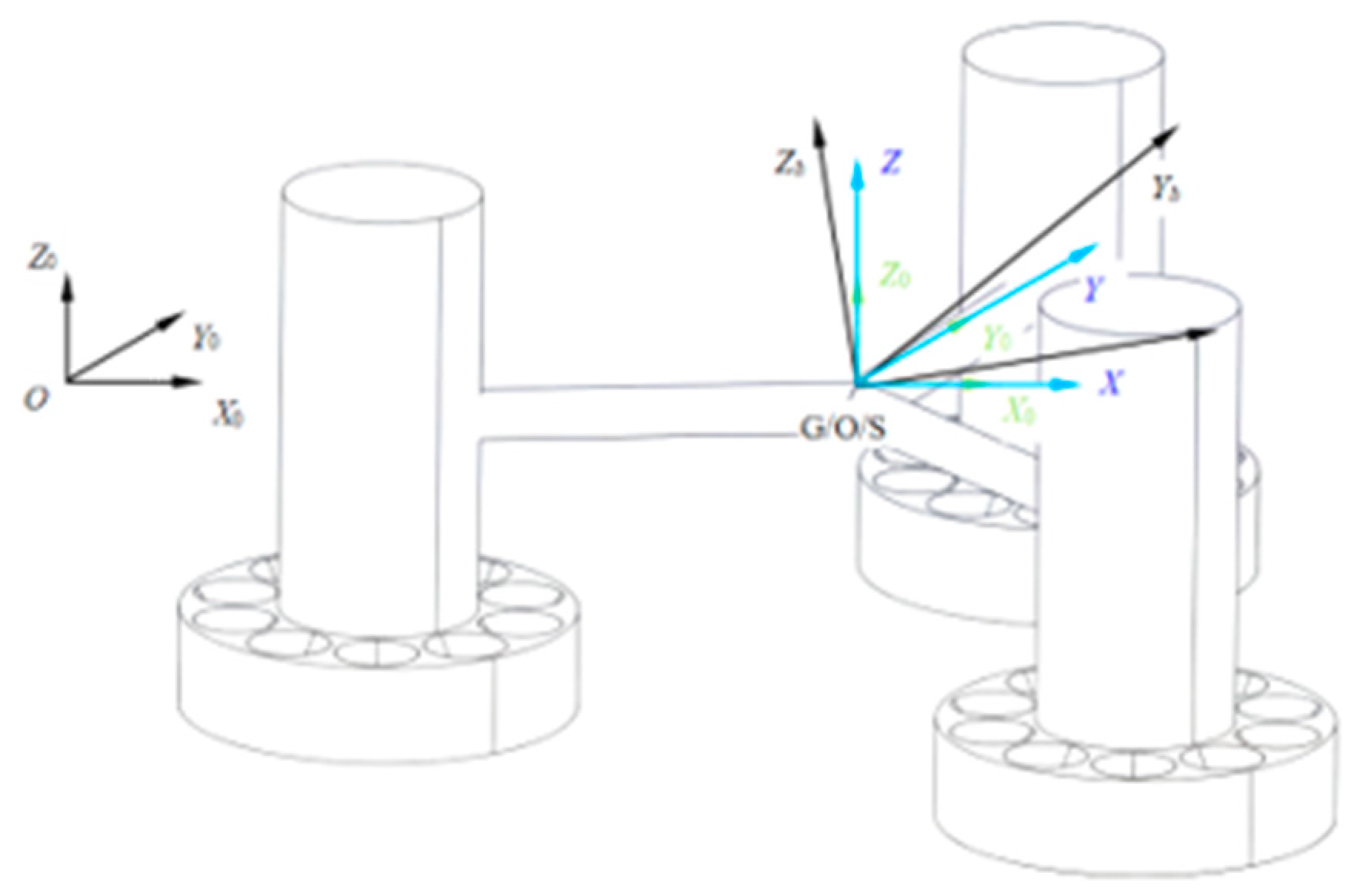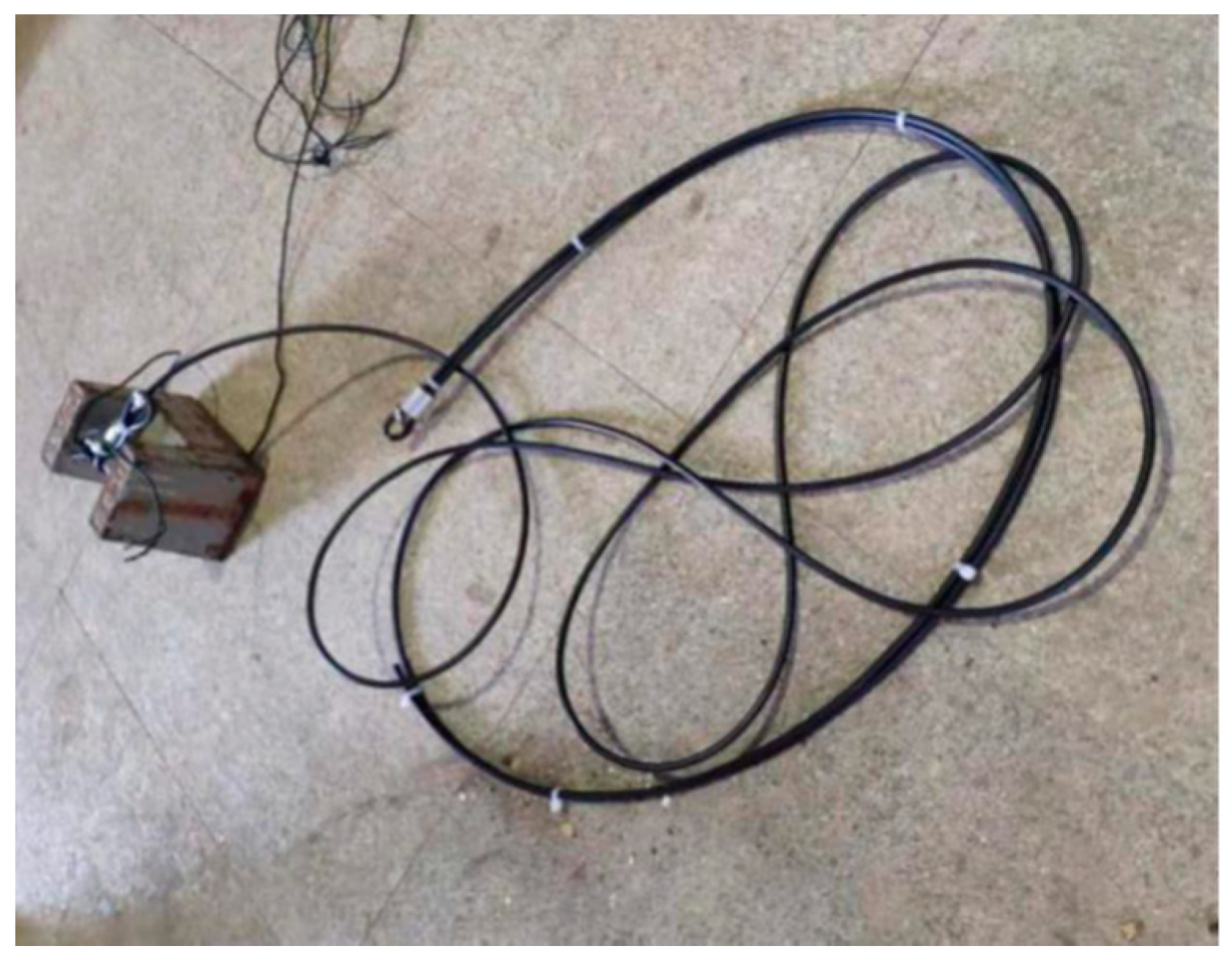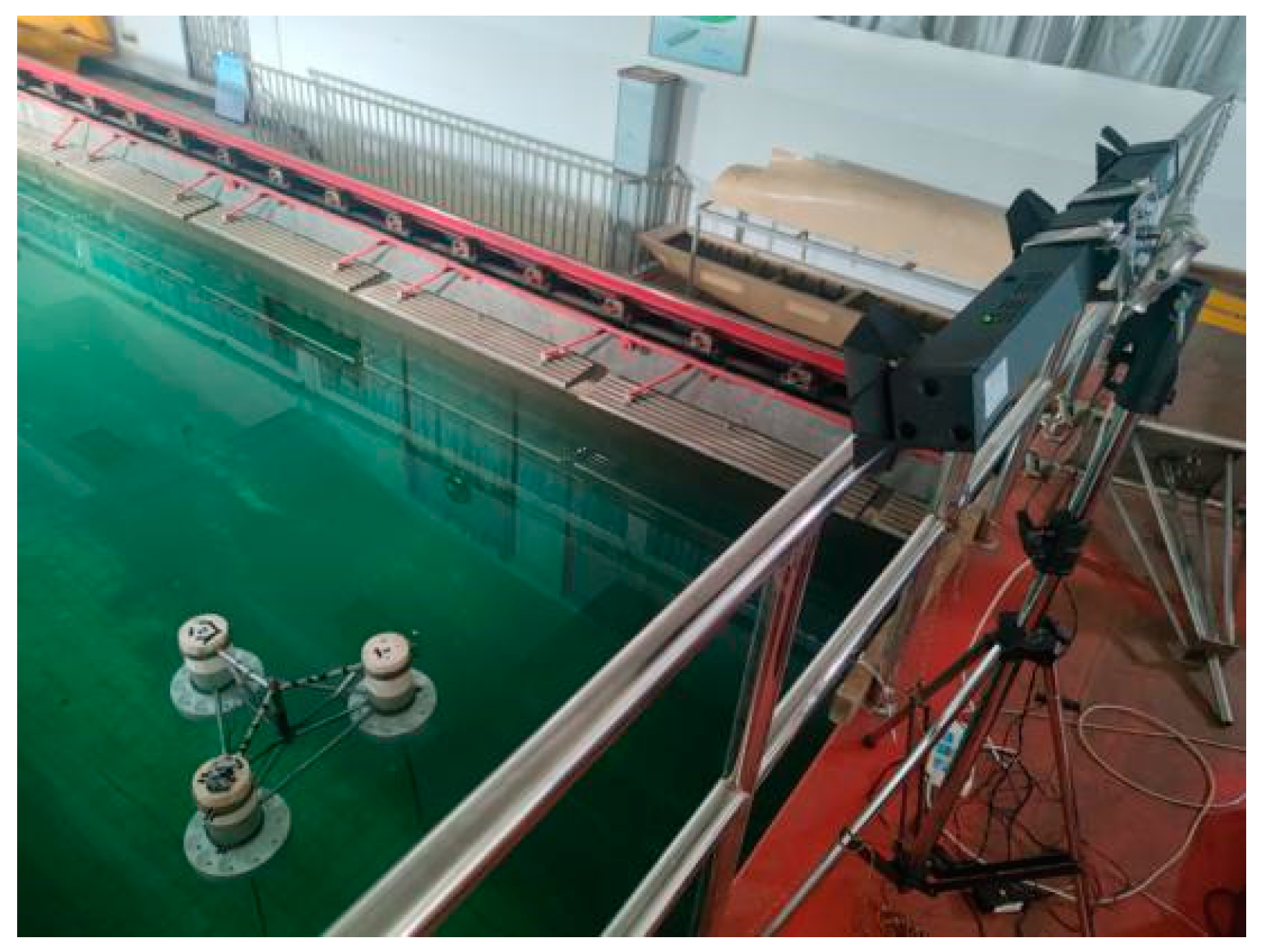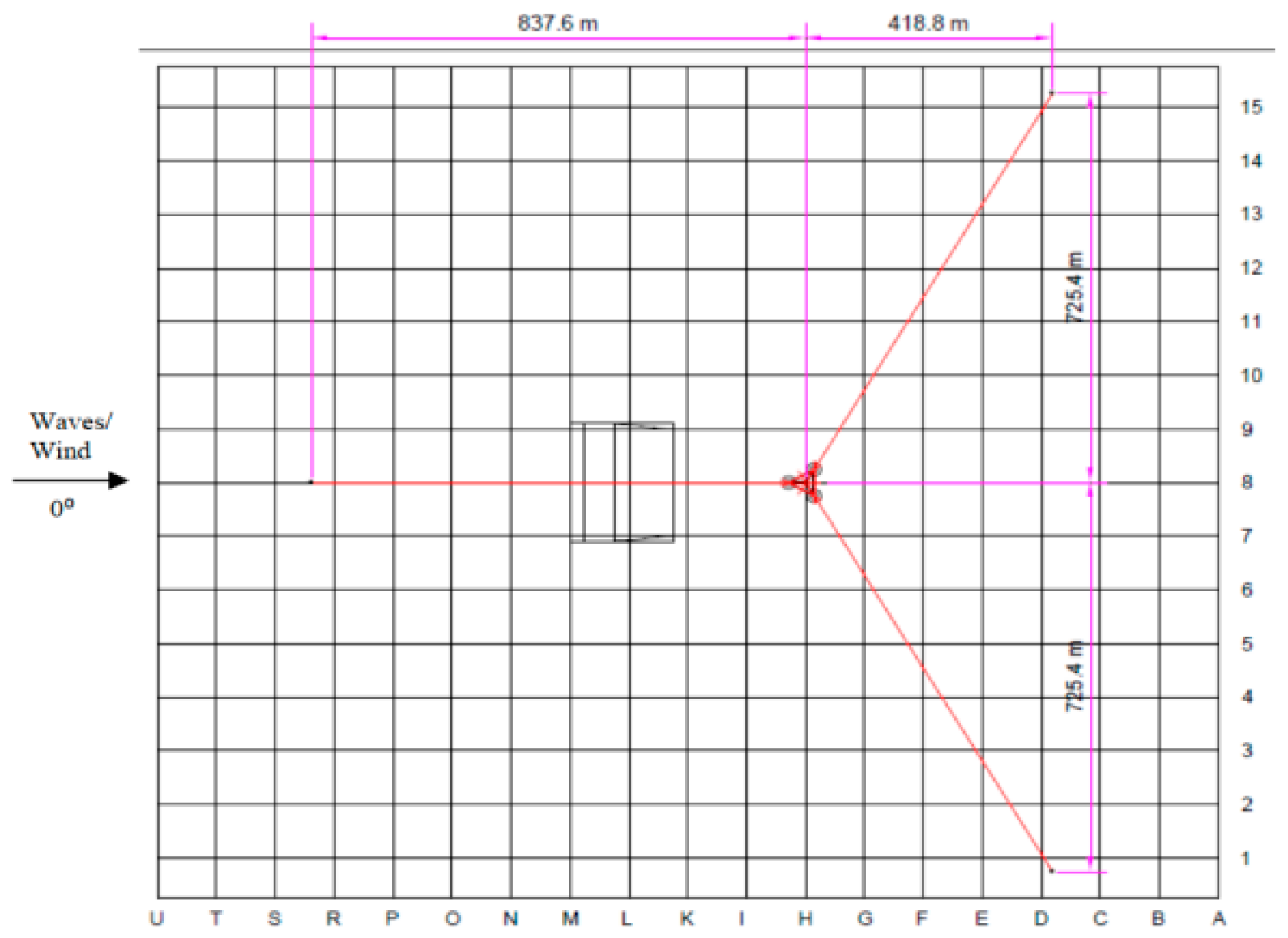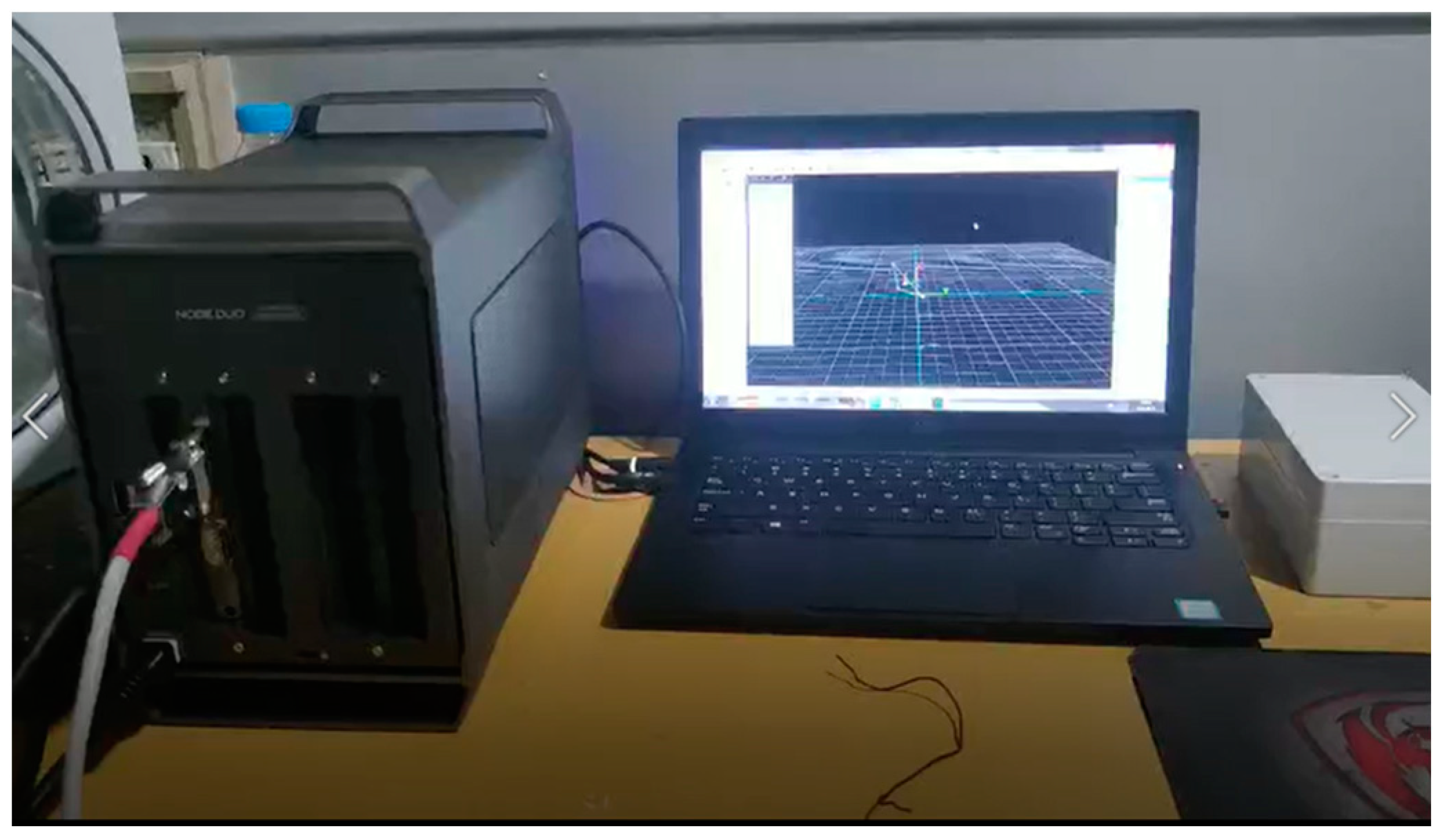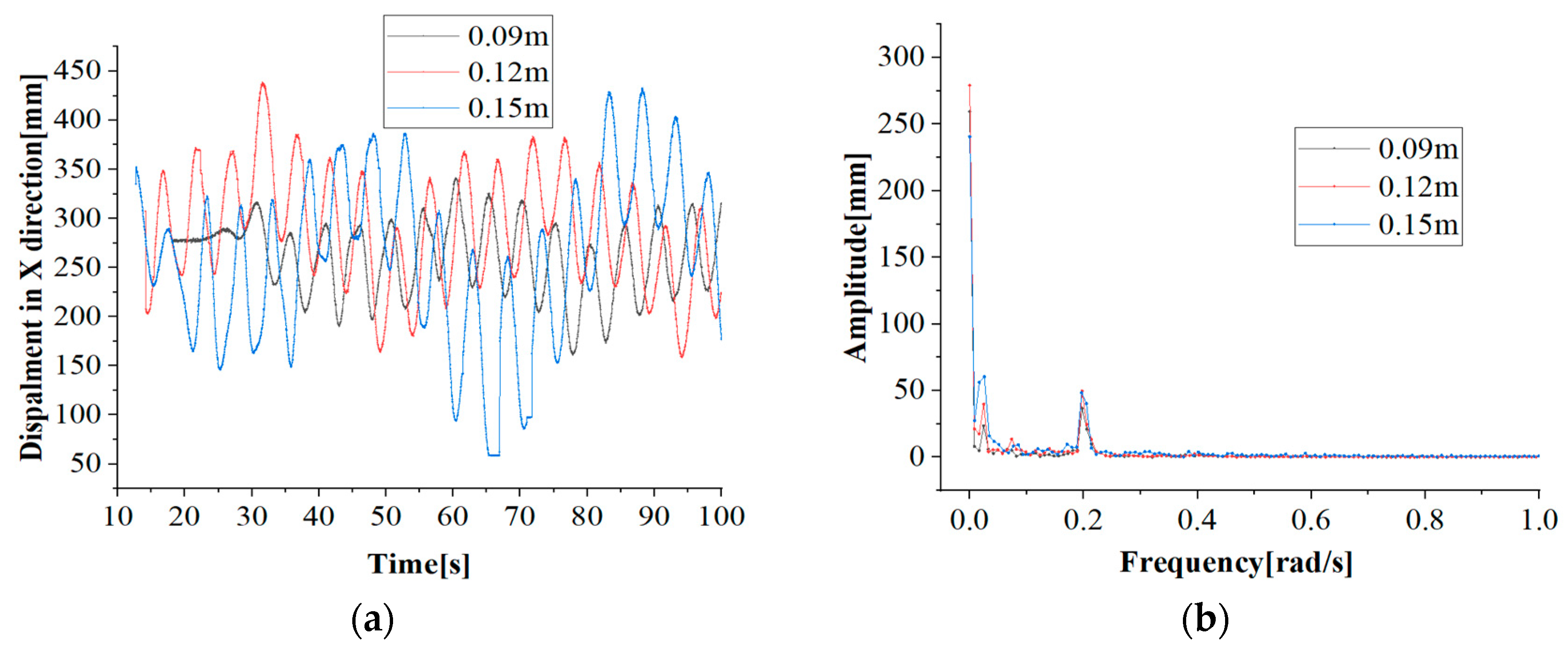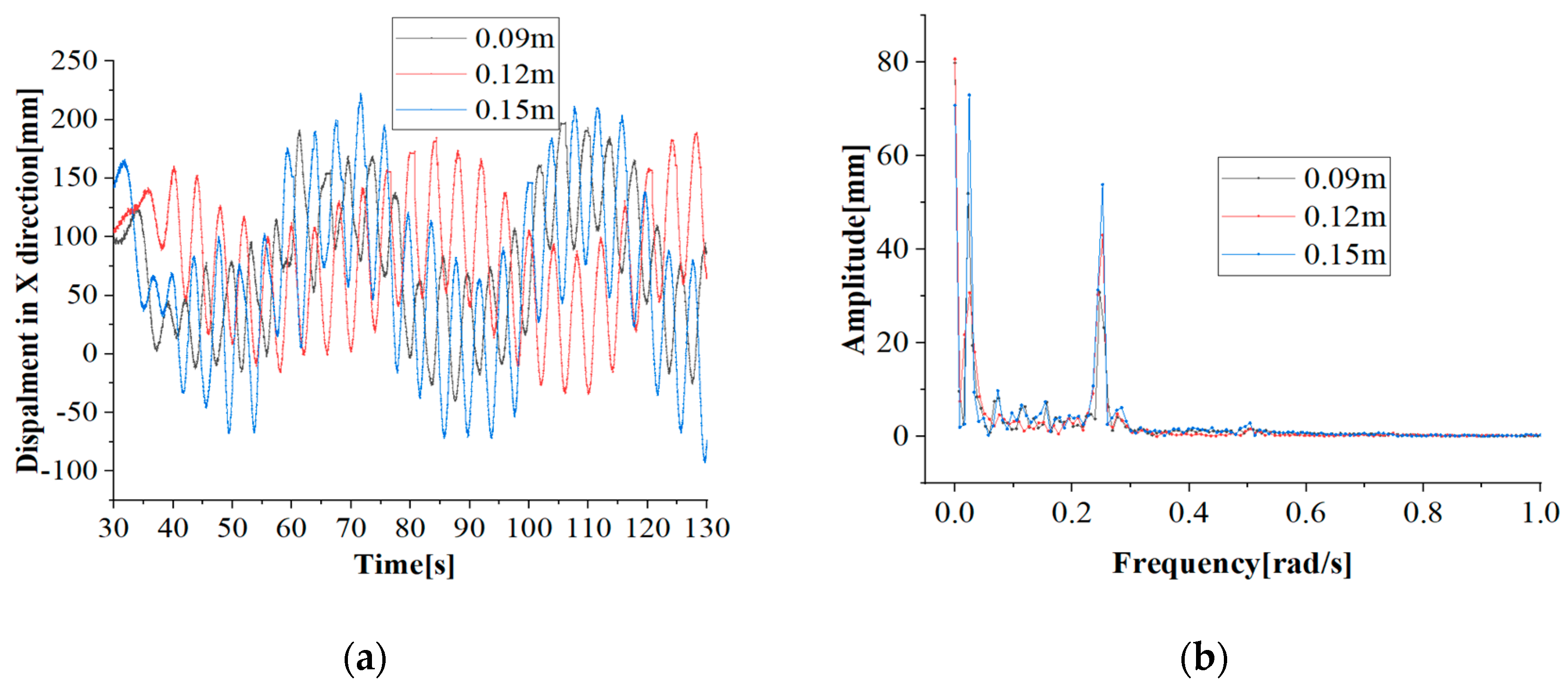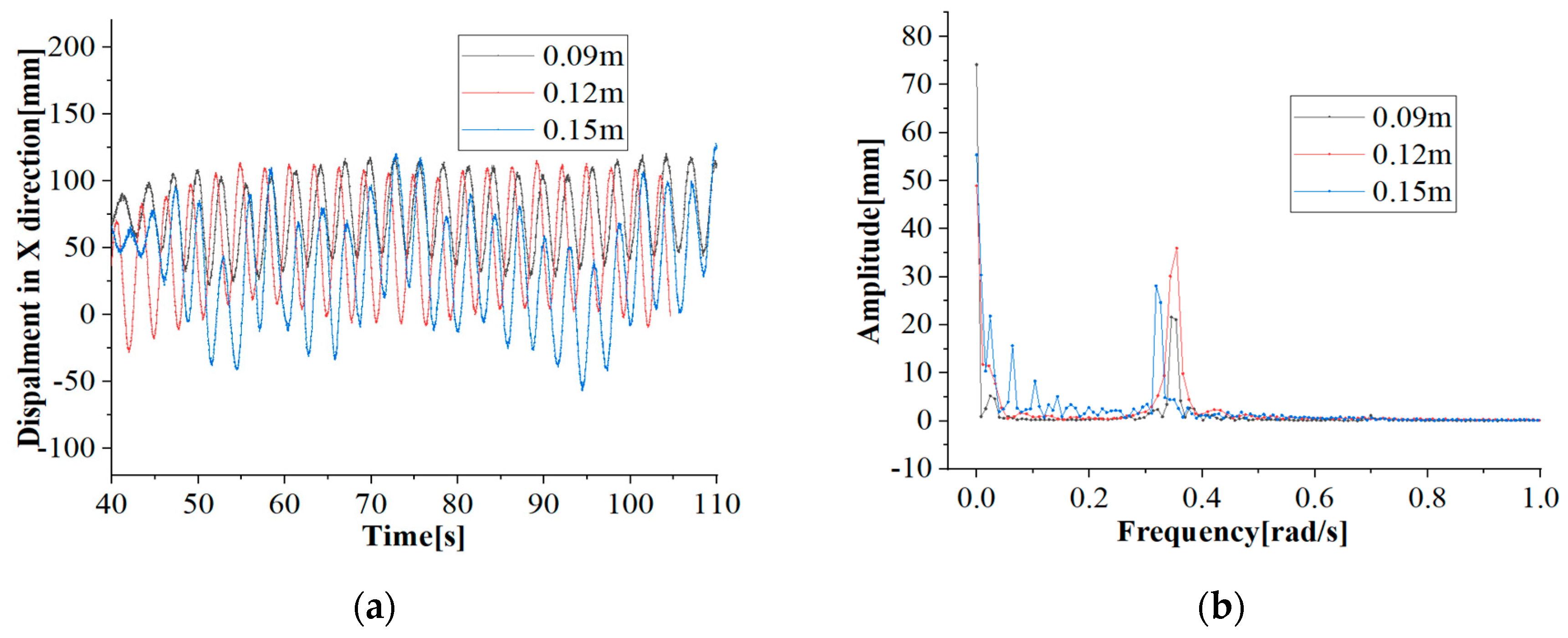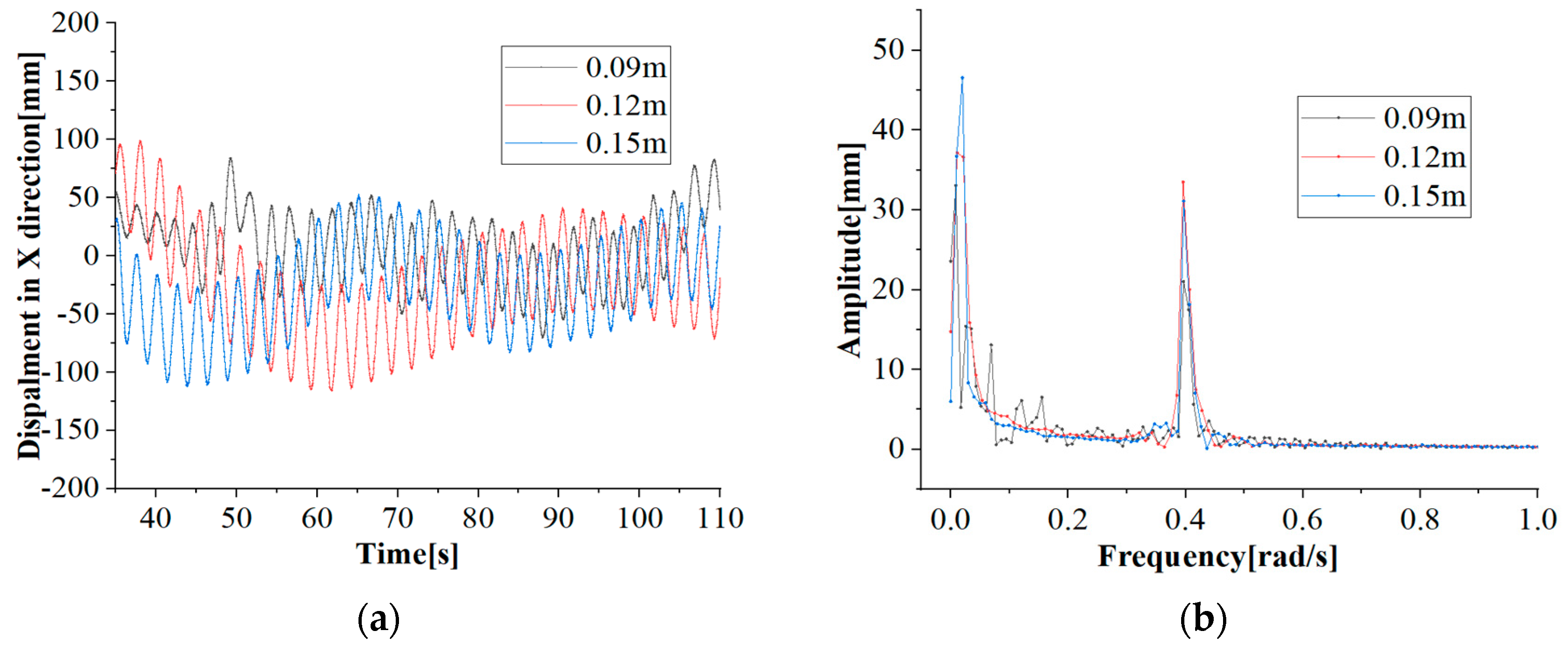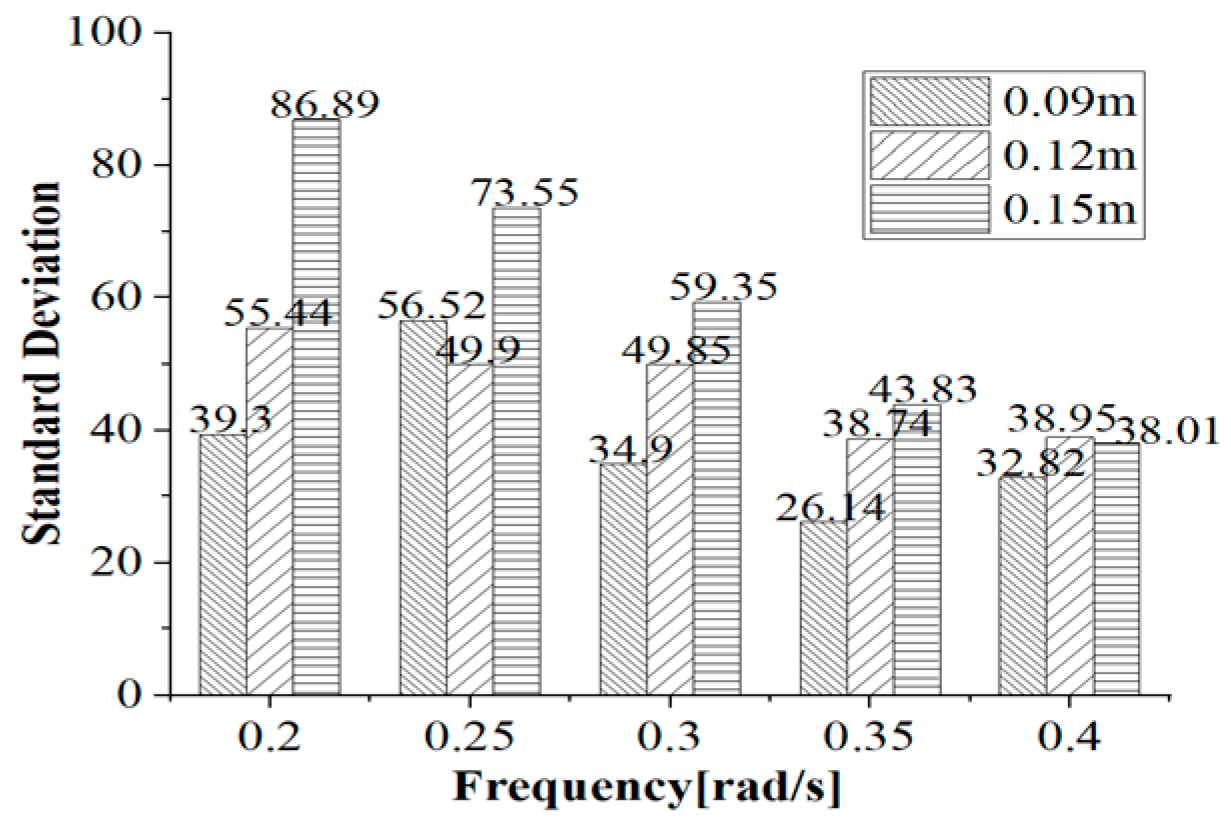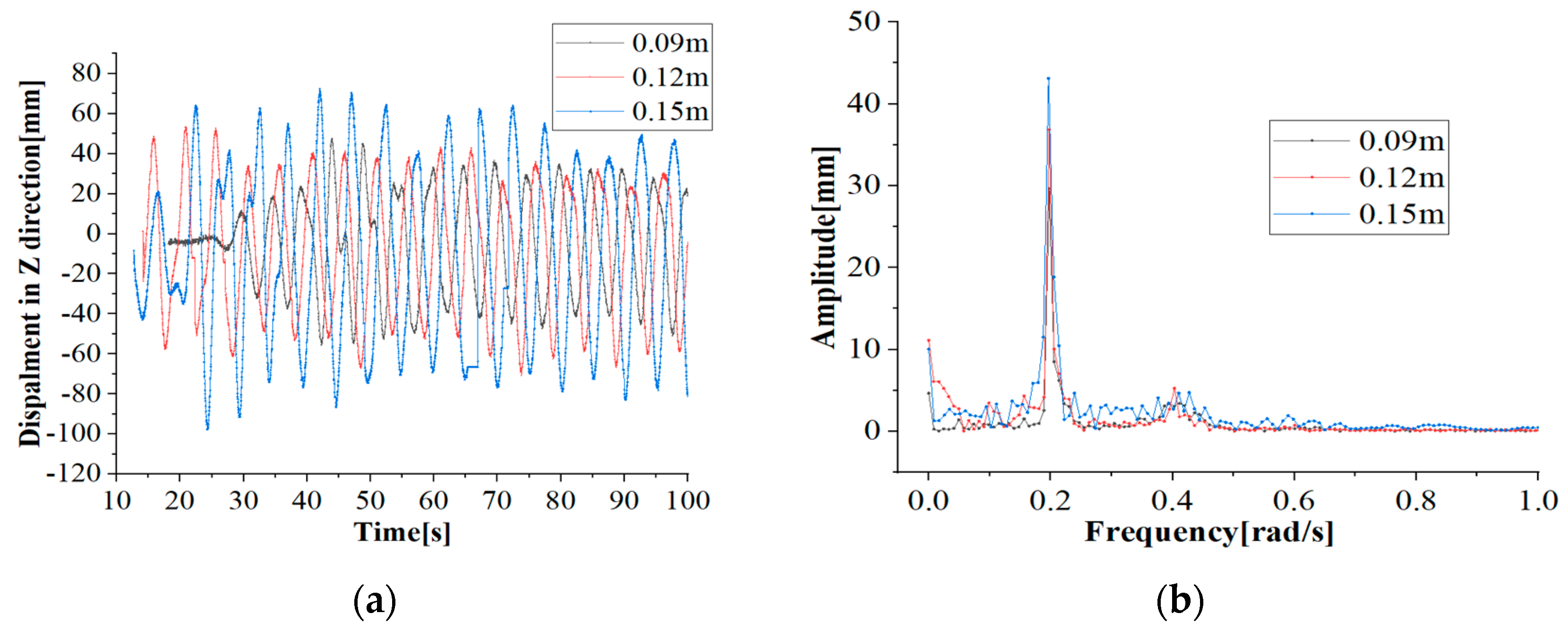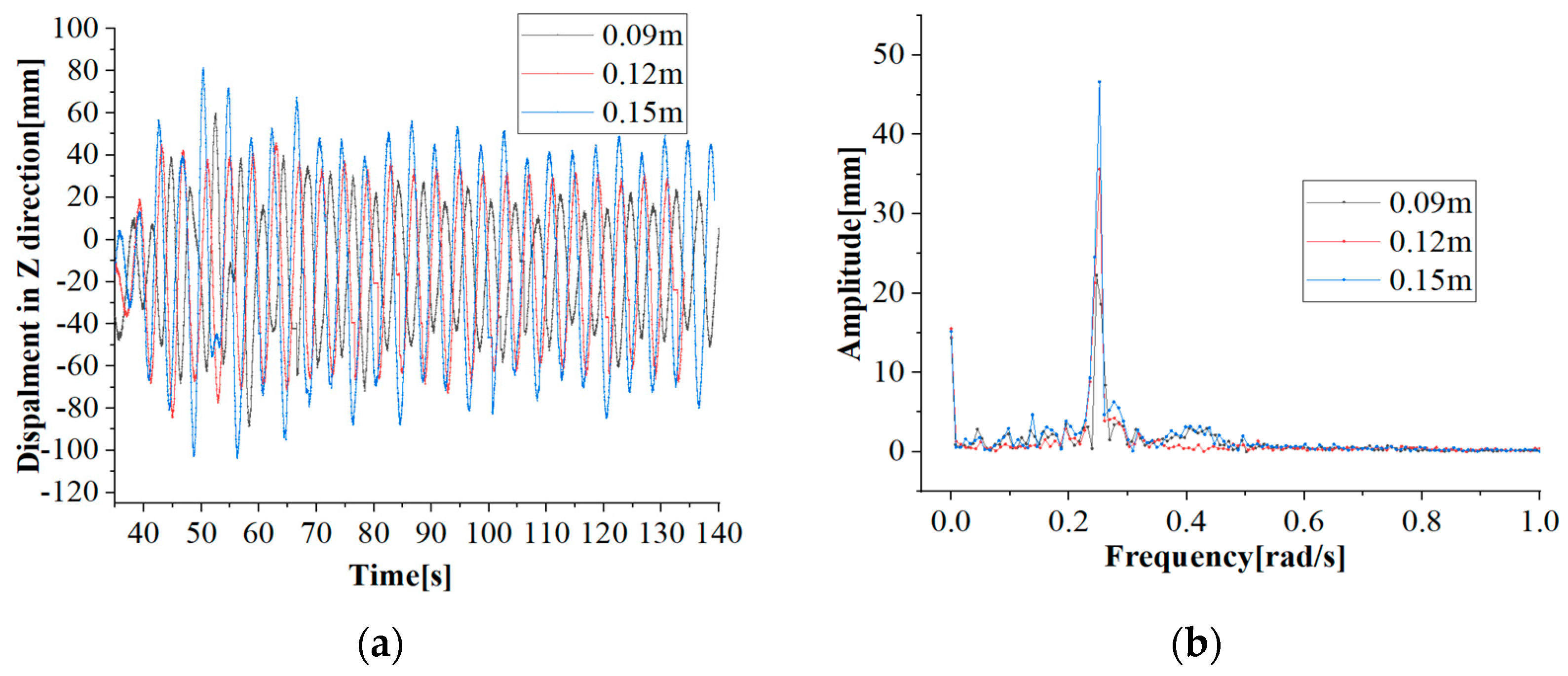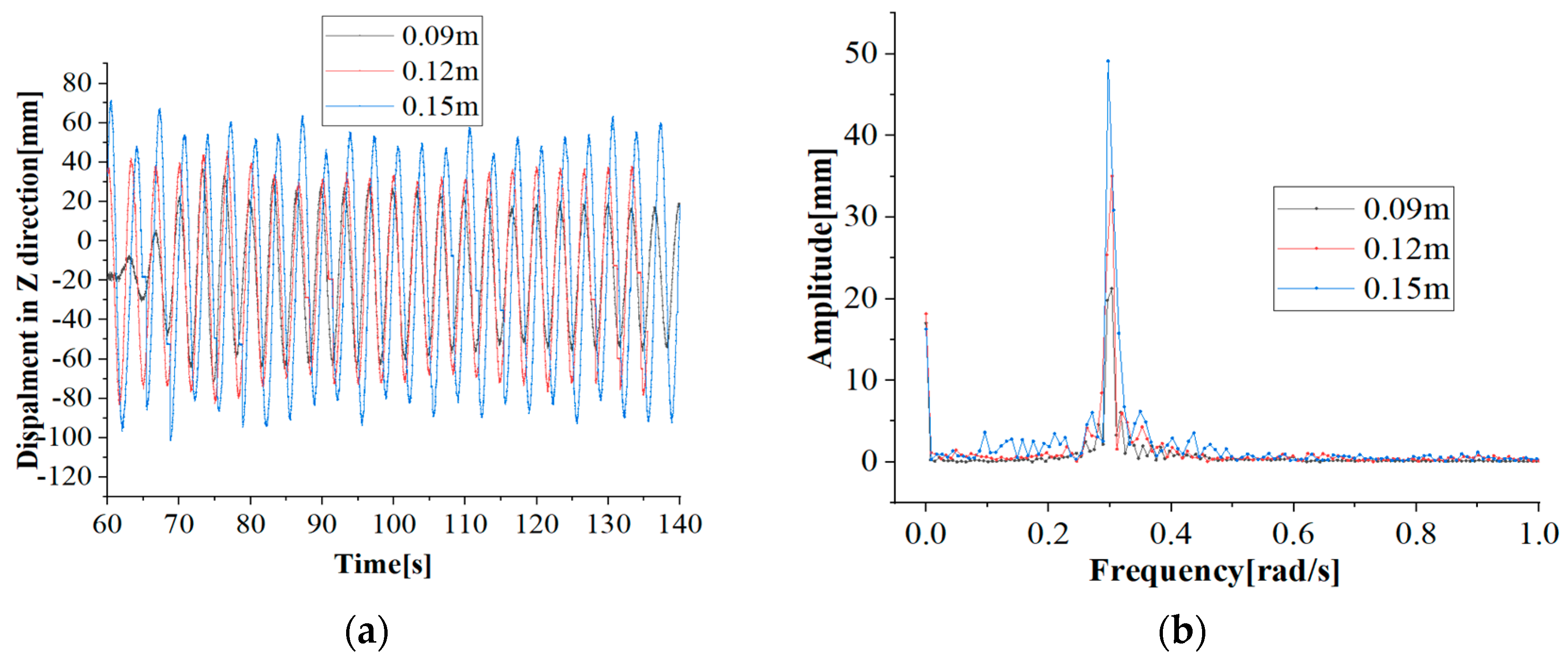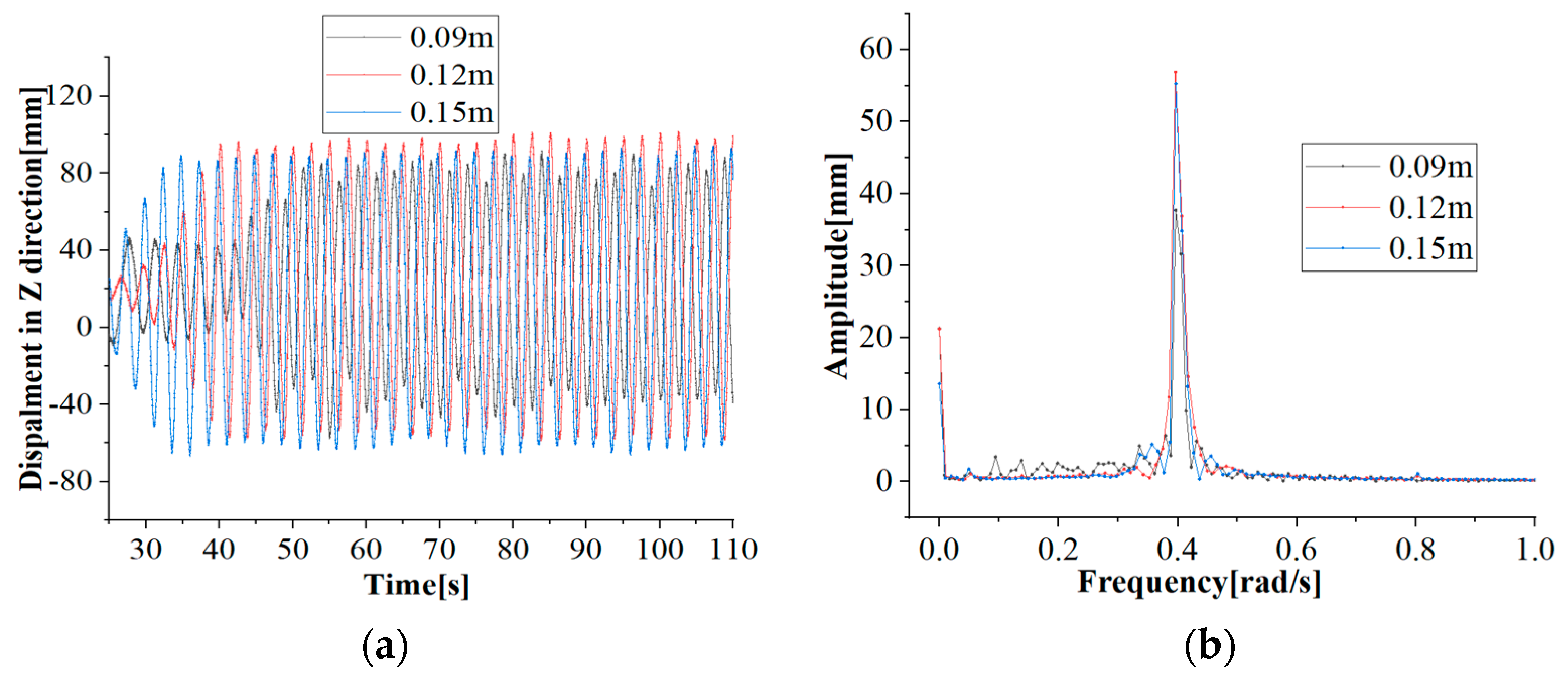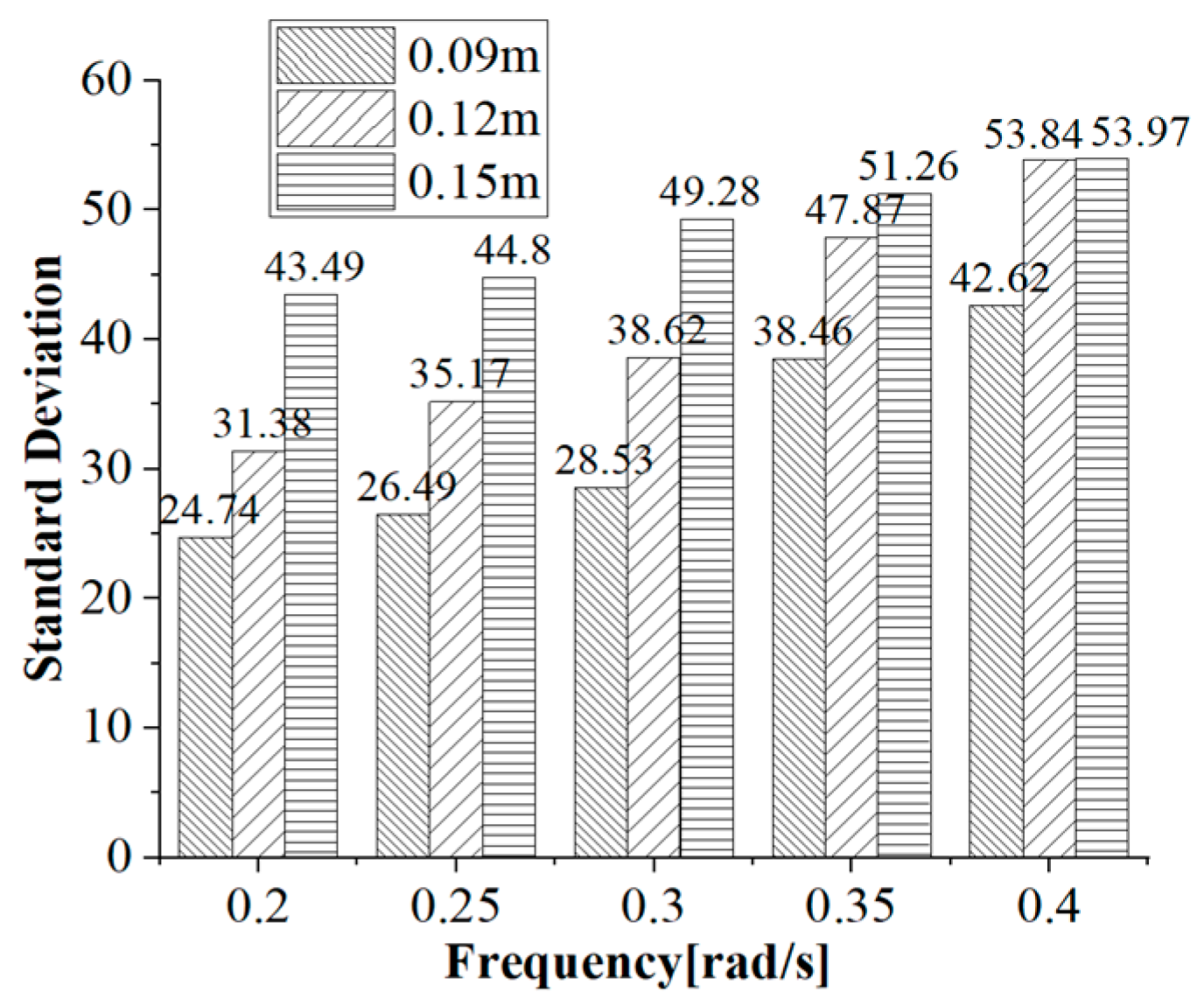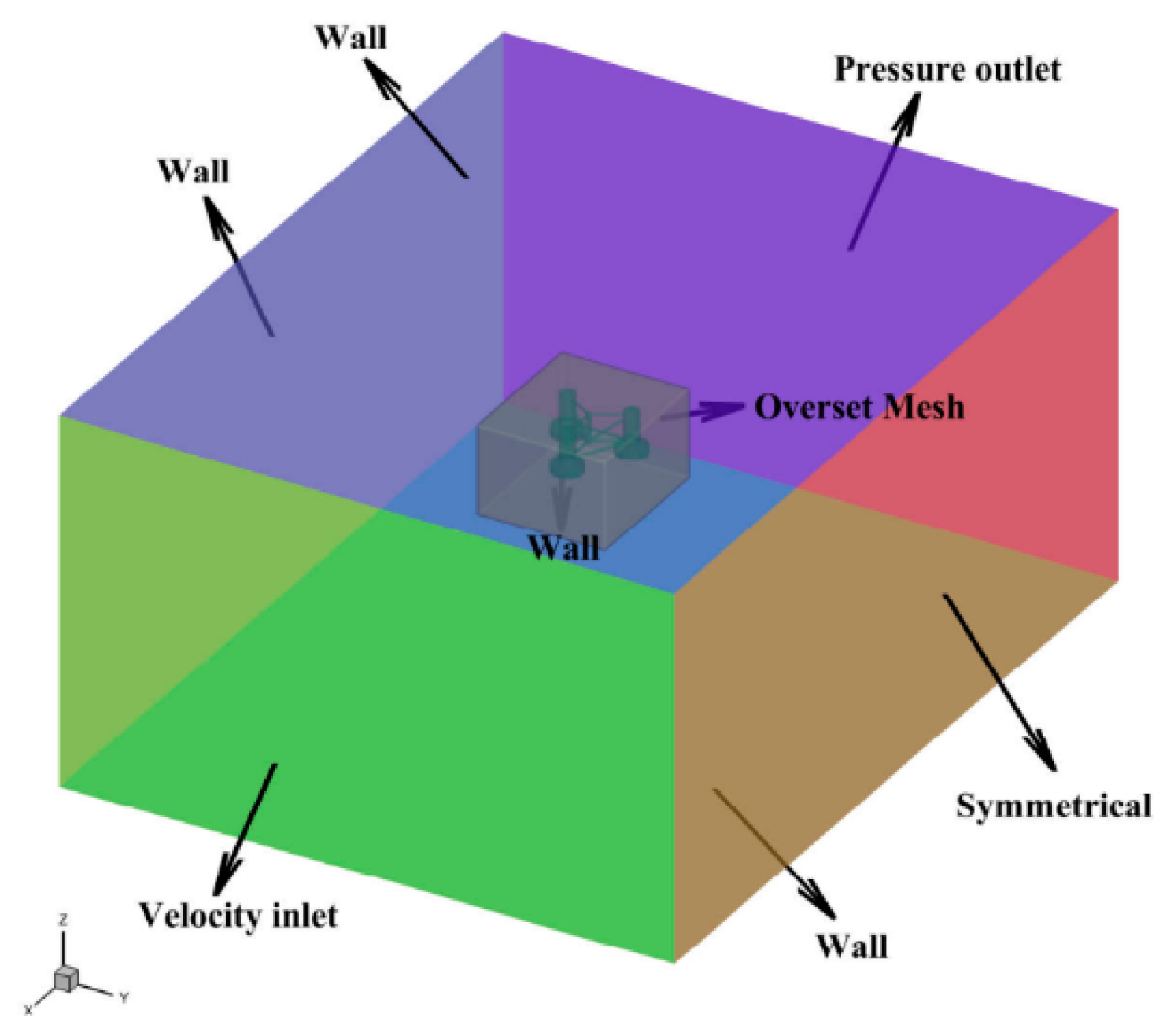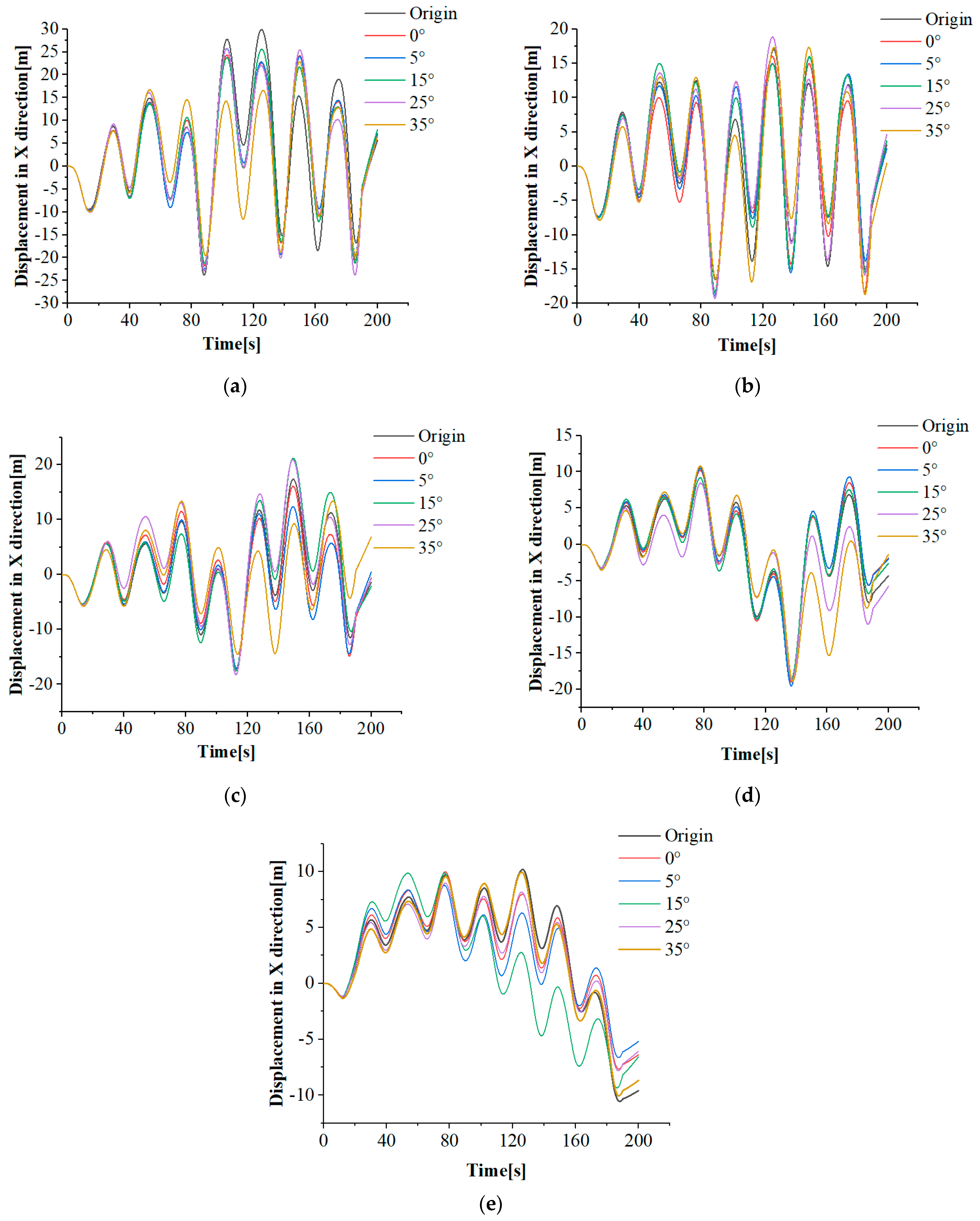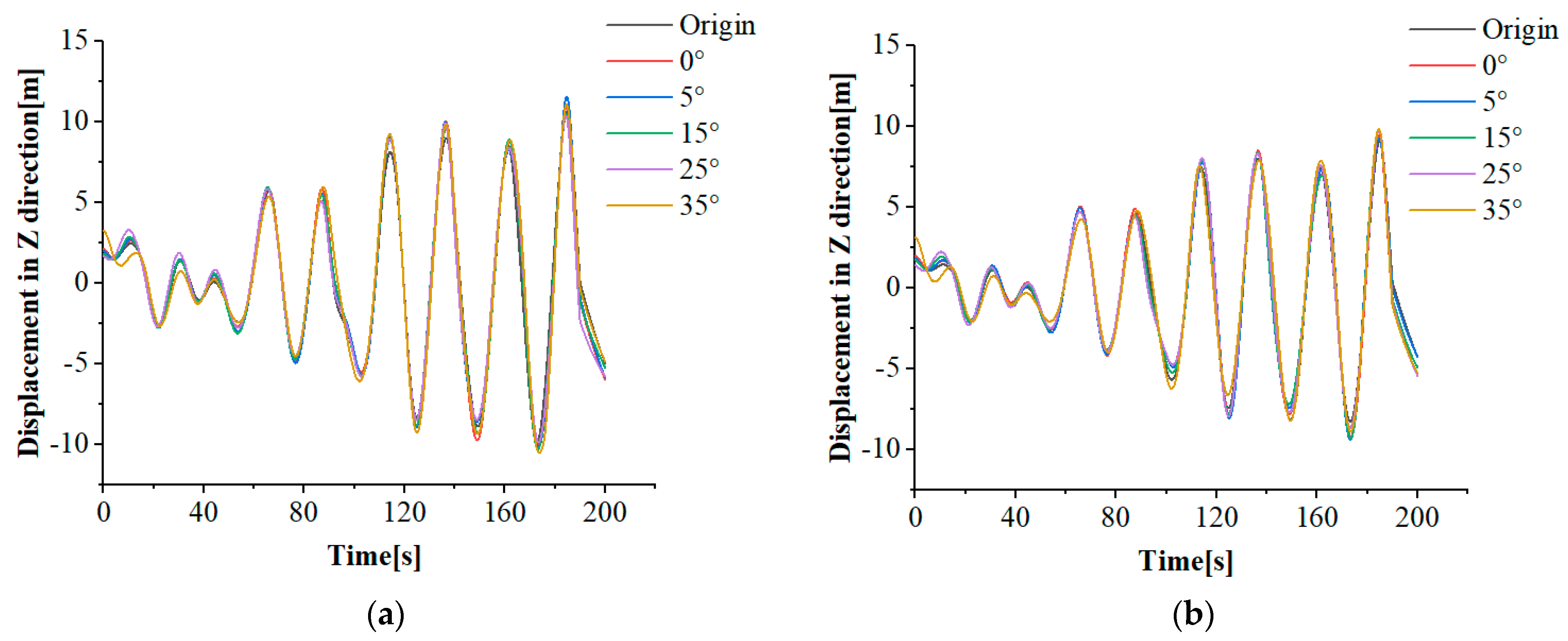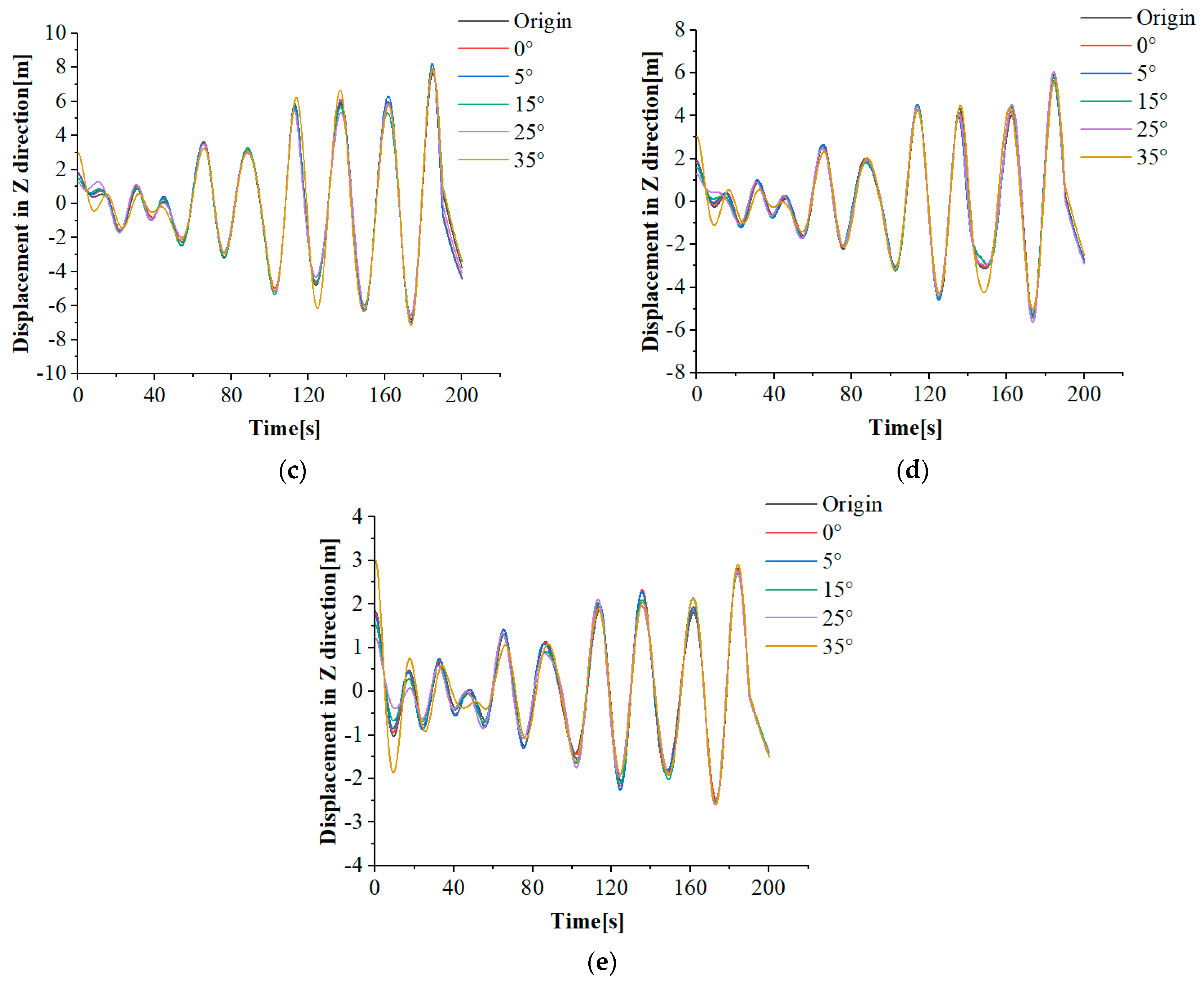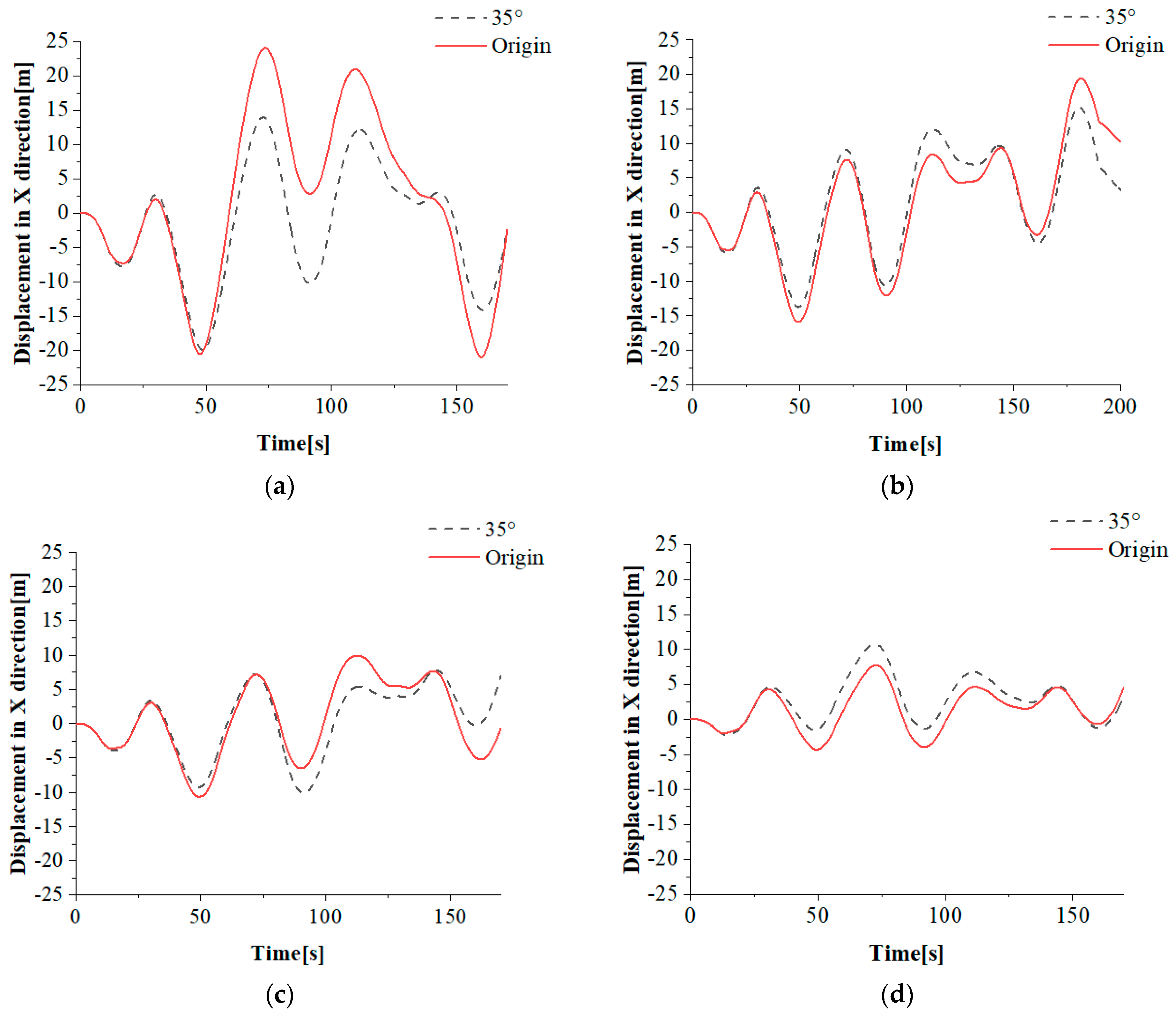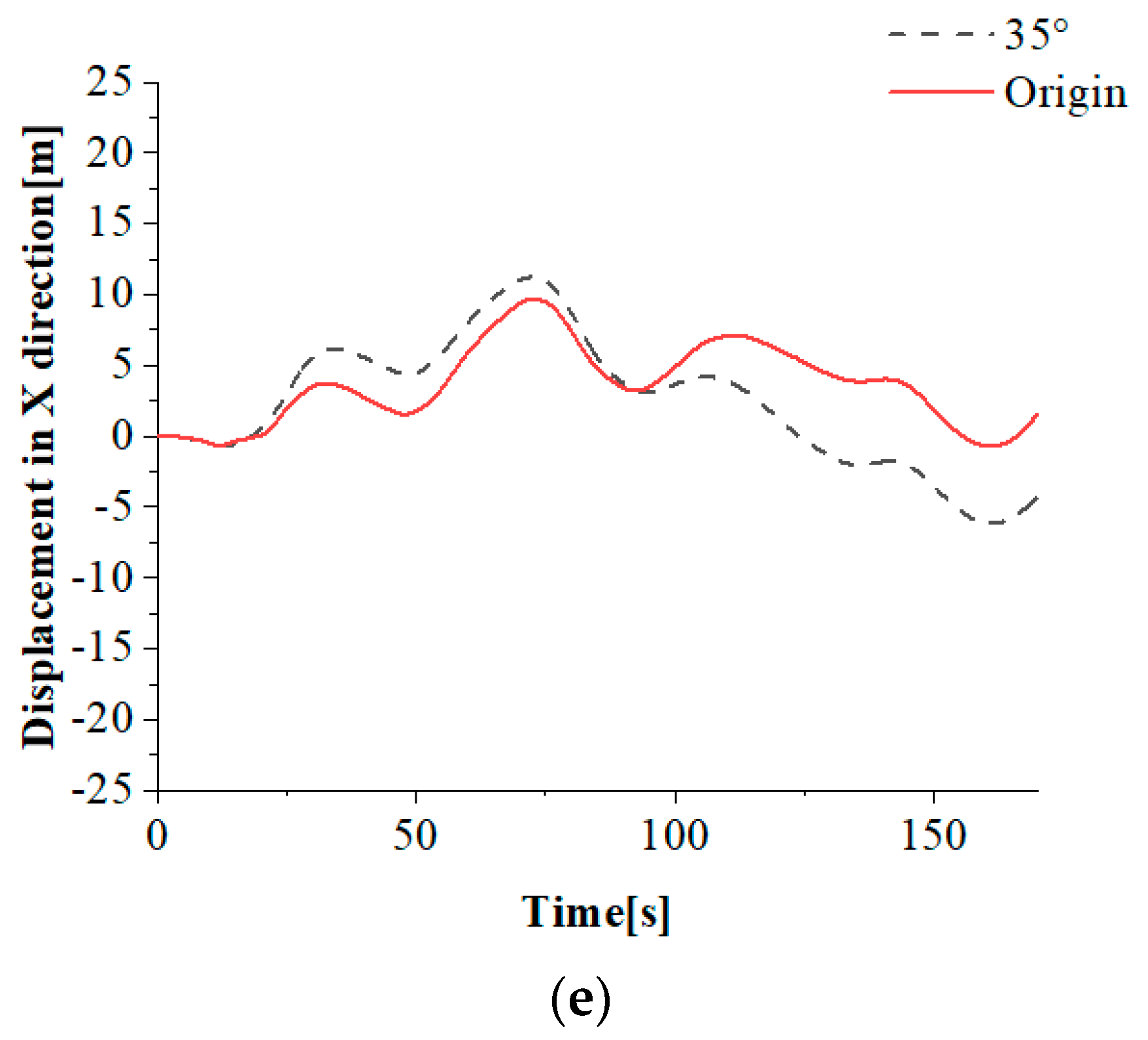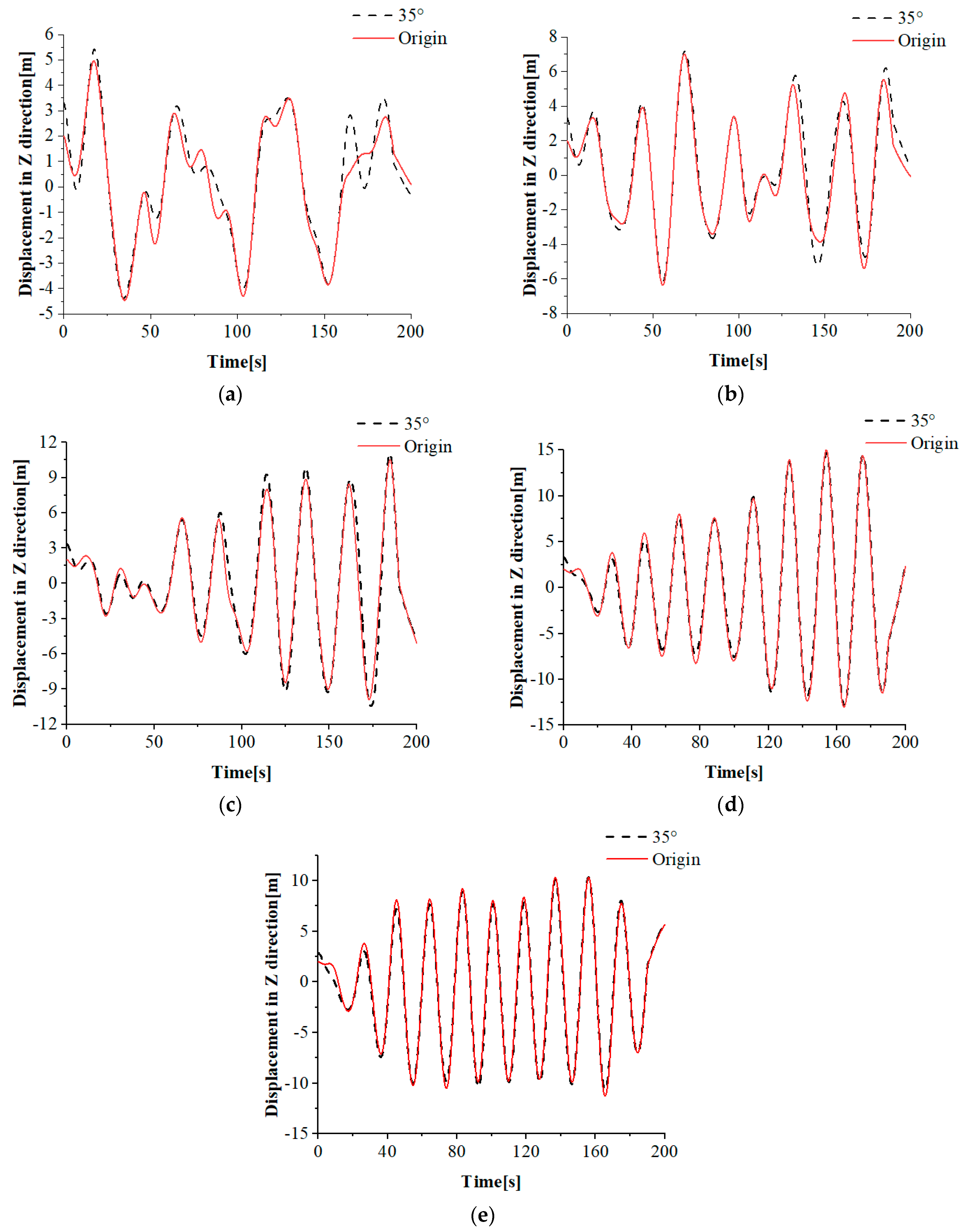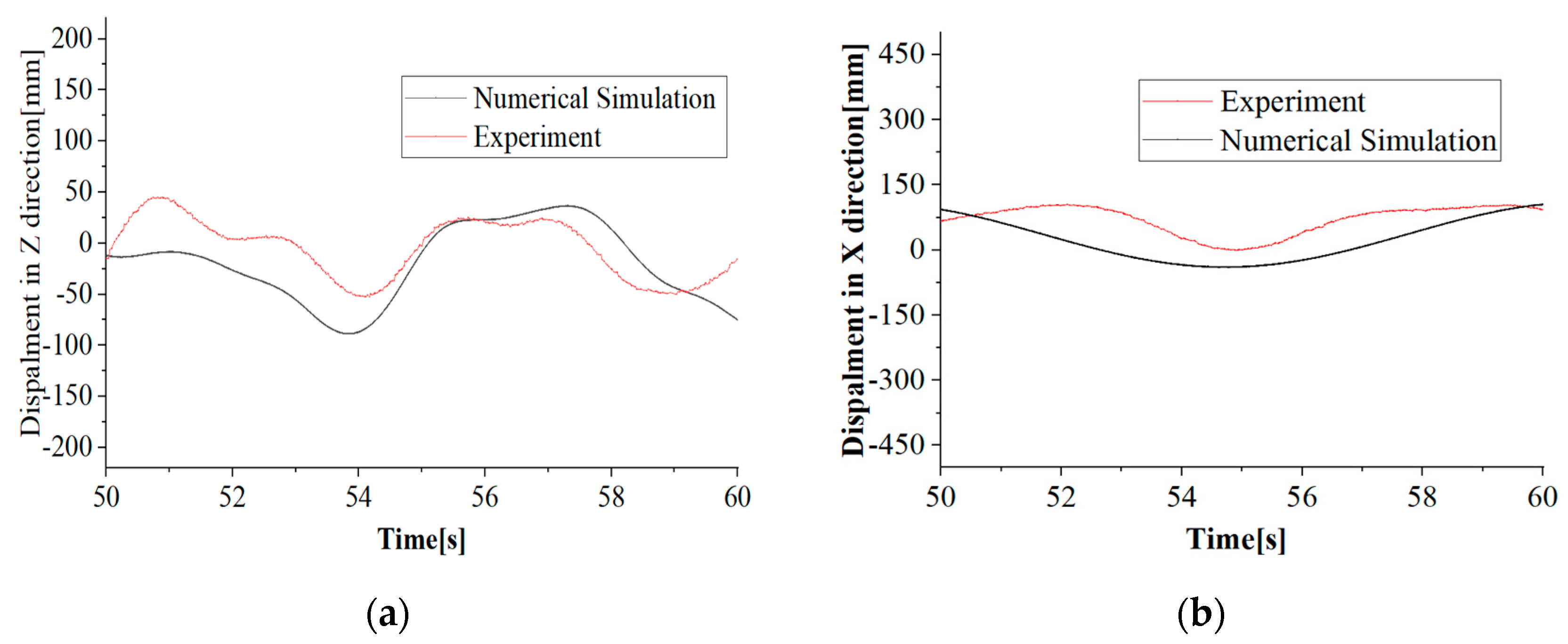Figure 1.
Single pontoon model.
Figure 1.
Single pontoon model.
Figure 2.
Cross-section of the heave plate.
Figure 2.
Cross-section of the heave plate.
Figure 3.
Simplified model.
Figure 3.
Simplified model.
Figure 4.
Simplified main pontoon and connection frame.
Figure 4.
Simplified main pontoon and connection frame.
Figure 5.
Model of the pedestal.
Figure 5.
Model of the pedestal.
Figure 6.
Coordinate system of the three-floating-body wind turbine platform.
Figure 6.
Coordinate system of the three-floating-body wind turbine platform.
Figure 7.
Wave altimeter.
Figure 7.
Wave altimeter.
Figure 8.
Wire rope and mooring block.
Figure 8.
Wire rope and mooring block.
Figure 9.
Installation of PTI 3D motion capture system on Trailer.
Figure 9.
Installation of PTI 3D motion capture system on Trailer.
Figure 10.
Installation diagram and capture system.
Figure 10.
Installation diagram and capture system.
Figure 11.
Common mooring method of the semi-wind turbine platform.
Figure 11.
Common mooring method of the semi-wind turbine platform.
Figure 12.
Experimental data acquisition system.
Figure 12.
Experimental data acquisition system.
Figure 13.
Surge response of the pedestal with different wave heights at 0.20 Hz. (a) Surge; (b) surge frequency domain curve.
Figure 13.
Surge response of the pedestal with different wave heights at 0.20 Hz. (a) Surge; (b) surge frequency domain curve.
Figure 14.
Surge response of the pedestal with different wave heights at 0.25 Hz. (a) Surge; (b) surge frequency domain curve.
Figure 14.
Surge response of the pedestal with different wave heights at 0.25 Hz. (a) Surge; (b) surge frequency domain curve.
Figure 15.
Surge response of the pedestal with different wave heights at 0.30 Hz. (a) Surge; (b) surge frequency domain curve.
Figure 15.
Surge response of the pedestal with different wave heights at 0.30 Hz. (a) Surge; (b) surge frequency domain curve.
Figure 16.
Surge response of the pedestal with different wave heights at 0.35 Hz. (a) Surge; (b) surge frequency domain curve.
Figure 16.
Surge response of the pedestal with different wave heights at 0.35 Hz. (a) Surge; (b) surge frequency domain curve.
Figure 17.
Surge response of the pedestal with different wave heights at 0.40 Hz. (a) Surge; (b) surge frequency domain curve.
Figure 17.
Surge response of the pedestal with different wave heights at 0.40 Hz. (a) Surge; (b) surge frequency domain curve.
Figure 18.
Standard deviation of surge response at different frequencies.
Figure 18.
Standard deviation of surge response at different frequencies.
Figure 19.
Heave response of the pedestal with different wave heights at 0.20 Hz. (a) Heave; (b) heave frequency domain curve.
Figure 19.
Heave response of the pedestal with different wave heights at 0.20 Hz. (a) Heave; (b) heave frequency domain curve.
Figure 20.
Heave response of the pedestal with different wave heights at 0.25 Hz. (a) Heave; (b) heave frequency domain curve.
Figure 20.
Heave response of the pedestal with different wave heights at 0.25 Hz. (a) Heave; (b) heave frequency domain curve.
Figure 21.
Heave response of the pedestal with different wave heights at 0.30 Hz. (a) Heave; (b) heave frequency domain curve.
Figure 21.
Heave response of the pedestal with different wave heights at 0.30 Hz. (a) Heave; (b) heave frequency domain curve.
Figure 22.
Heave response of the pedestal with different wave heights at 0.35 Hz. (a) Heave; (b) heave frequency domain curve.
Figure 22.
Heave response of the pedestal with different wave heights at 0.35 Hz. (a) Heave; (b) heave frequency domain curve.
Figure 23.
Heave response of the pedestal with different wave heights at 0.40 Hz. (a) Heave; (b) heave frequency domain curve.
Figure 23.
Heave response of the pedestal with different wave heights at 0.40 Hz. (a) Heave; (b) heave frequency domain curve.
Figure 24.
Standard deviation of heave response at different frequencies.
Figure 24.
Standard deviation of heave response at different frequencies.
Figure 25.
Schematic of boundary conditions.
Figure 25.
Schematic of boundary conditions.
Figure 26.
Mooring arrangement diagram.
Figure 26.
Mooring arrangement diagram.
Figure 27.
Schematic of numerical simulation mesh.
Figure 27.
Schematic of numerical simulation mesh.
Figure 28.
X direction displacement of the pedestal under different chamfers. (a) H = 9 m; (b) H = 7.2 m; (c) H = 5.4 m; (d) H = 3.6 m; (e) H = 1.8 m.
Figure 28.
X direction displacement of the pedestal under different chamfers. (a) H = 9 m; (b) H = 7.2 m; (c) H = 5.4 m; (d) H = 3.6 m; (e) H = 1.8 m.
Figure 29.
Z direction displacement of the pedestal under different chamfers. (a) H = 9 m; (b) H = 7.2 m; (c) H = 5.4 m; (d) H = 3.6 m; (e) H = 1.8 m.
Figure 29.
Z direction displacement of the pedestal under different chamfers. (a) H = 9 m; (b) H = 7.2 m; (c) H = 5.4 m; (d) H = 3.6 m; (e) H = 1.8 m.
Figure 30.
X direction displacement of the pedestal under different wave heights. (a) H = 9 m; (b) H = 7.2 m; (c) H = 5.4 m; (d) H = 3.6 m; (e) H = 1.8 m.
Figure 30.
X direction displacement of the pedestal under different wave heights. (a) H = 9 m; (b) H = 7.2 m; (c) H = 5.4 m; (d) H = 3.6 m; (e) H = 1.8 m.
Figure 31.
Z direction displacement of the pedestal under different wave heights. (a) H = 9 m; (b) H = 7.2 m; (c) H = 5.4 m; (d) H = 3.6 m; (e) H = 1.8 m.
Figure 31.
Z direction displacement of the pedestal under different wave heights. (a) H = 9 m; (b) H = 7.2 m; (c) H = 5.4 m; (d) H = 3.6 m; (e) H = 1.8 m.
Figure 32.
X direction displacement of the pedestal under different wave periods. (a) T = 38.73 s; (b) T = 30.98 s; (c) T = 25.82 s; (d) T = 22.13 s; (e) T = 19.36 s.
Figure 32.
X direction displacement of the pedestal under different wave periods. (a) T = 38.73 s; (b) T = 30.98 s; (c) T = 25.82 s; (d) T = 22.13 s; (e) T = 19.36 s.
Figure 33.
Z direction displacement of the pedestal under different wave periods. (a) T = 38.73 s; (b) T = 30.98 s; (c) T = 25.82 s; (d) T = 22.13 s; (e) T = 19.36 s.
Figure 33.
Z direction displacement of the pedestal under different wave periods. (a) T = 38.73 s; (b) T = 30.98 s; (c) T = 25.82 s; (d) T = 22.13 s; (e) T = 19.36 s.
Figure 34.
Comparison between numerical simulation and experiment at LC1. (a) Heave; (b) surge.
Figure 34.
Comparison between numerical simulation and experiment at LC1. (a) Heave; (b) surge.
Figure 35.
Comparison between numerical simulation and experiment at LC4. (a) Heave; (b) surge.
Figure 35.
Comparison between numerical simulation and experiment at LC4. (a) Heave; (b) surge.
Table 1.
Pontoon and connecting parts data.
Table 1.
Pontoon and connecting parts data.
| Characteristic Parameter | Value |
|---|
| Height of pontoon [m] | 32 |
| Height of anti-heave device [m] | 6 |
| Diameter of pontoon [m] | 12 |
| Diameter of anti-heave device [m] | 24 |
| Number of perforations | 10 |
| Perforation chamfer [°] | 35 |
| Height of central column [m] | 24 |
| Diameter of central column [m] | 3.6 |
| Diameter of inclined column [m] | 1.92 |
| Thickness of inclined column [m] | 0.168 |
| Total mass [kg] | 1.35 × 107 |
| Radius of the inertia [m] | 89.20 |
Table 2.
Working condition of wave maker.
Table 2.
Working condition of wave maker.
| Condition Number | Frequencies [Hz] | Wave Periods [s] | Wave Heights [m] |
|---|
| 1 | 0.20 | 5.00 | 0.09 |
| 2 | 0.20 | 5.00 | 0.12 |
| 3 | 0.20 | 5.00 | 0.15 |
| 4 | 0.25 | 4.00 | 0.09 |
| 5 | 0.25 | 4.00 | 0.12 |
| 6 | 0.25 | 4.00 | 0.15 |
| 7 | 0.30 | 3.33 | 0.09 |
| 8 | 0.30 | 3.33 | 0.12 |
| 9 | 0.30 | 3.33 | 0.15 |
| 10 | 0.35 | 2.86 | 0.09 |
| 11 | 0.35 | 2.86 | 0.12 |
| 12 | 0.35 | 2.86 | 0.15 |
| 13 | 0.40 | 2.50 | 0.09 |
| 14 | 0.40 | 2.50 | 0.12 |
| 15 | 0.40 | 2.50 | 0.15 |
Table 3.
Working conditions of waves.
Table 3.
Working conditions of waves.
| Wave Periods [s] | Wave Heights [m] |
|---|
| 19.36 | 9.0 |
| 22.13 | 7.2 |
| 25.82 | 5.4 |
| 30.98 | 3.6 |
| 38.73 | 1.8 |
Table 4.
The working condition of numerical simulation.
Table 4.
The working condition of numerical simulation.
| Wave Periods [s] | Wave Heights [m] | Chamfer Angle [°] |
|---|
| 19.36 | 9.0 | 0 |
| 22.13 | 7.2 | 5 |
| 25.82 | 5.4 | 15 |
| 30.98 | 3.6 | 25 |
| 38.73 | 1.8 | 35 |
Table 5.
Mean absolute deviation between the motion in the X direction in each case [m].
Table 5.
Mean absolute deviation between the motion in the X direction in each case [m].
| Chamfer Angle [°] | Wave Heights [m] |
|---|
| 1.8 | 3.6 | 5.4 | 7.2 | 9 |
|---|
| 0 | 0.998 | 0.724 | 1.481 | 2.239 | 2.775 |
| 5 | 1.809 | 0.838 | 1.881 | 2.180 | 2.653 |
| 15 | 3.057 | 0.754 | 1.497 | 1.930 | 2.586 |
| 25 | 0.911 | 1.672 | 1.810 | 1.566 | 3.355 |
| 35 | 0.543 | 2.716 | 3.826 | 1.897 | 5.355 |
Table 6.
Mean absolute deviation between the motion in Z direction in each case [m].
Table 6.
Mean absolute deviation between the motion in Z direction in each case [m].
| Chamfer Angle [°] | Wave Heights [m] |
|---|
| 1.8 | 3.6 | 5.4 | 7.2 | 9 |
|---|
| 0 | 0.059 | 0.102 | 0.176 | 0.433 | 0.417 |
| 5 | 0.092 | 0.179 | 0.220 | 0.399 | 0.460 |
| 15 | 0.133 | 0.200 | 0.195 | 0.402 | 0.402 |
| 25 | 0.193 | 0.222 | 0.244 | 0.411 | 0.586 |
| 35 | 0.179 | 0.314 | 0.377 | 0.453 | 0.569 |
Table 7.
The condition of numerical simulation.
Table 7.
The condition of numerical simulation.
| Condition Number | Wave Heights [m] | Wave Periods [s] |
|---|
| 1 | 9.0 | 38.73 |
| 2 | 7.2 | 38.73 |
| 3 | 5.4 | 38.73 |
| 4 | 3.6 | 38.73 |
| 5 | 1.8 | 38.73 |
Table 8.
The working condition of numerical simulation.
Table 8.
The working condition of numerical simulation.
| Condition Number [s] | Wave Periods | Wave Heights [m] |
|---|
| 1 | 19.36 | 9 |
| 2 | 22.13 | 9 |
| 3 | 25.82 | 9 |
| 4 | 30.98 | 9 |
| 5 | 38.73 | 9 |
Table 9.
Summary of simulation and experiment results [mm].
Table 9.
Summary of simulation and experiment results [mm].
| Condition Number | Frequencies [Hz] | Wave Heights [m] | Standard Deviation of Heave | Standard Deviation of Surge |
|---|
| Experiment | Simulation | Experiment | Simulation |
|---|
| 1 | 0.20 | 0.09 | 24.74 | 28.96 | 39.30 | 68.23 |
| 2 | 0.20 | 0.12 | 31.38 | 35.68 | 55.44 | 83.52 |
| 3 | 0.20 | 0.15 | 43.49 | 54.23 | 86.89 | 97.46 |
| 4 | 0.25 | 0.09 | 26.49 | 28.66 | 56.52 | 68.51 |
| 5 | 0.25 | 0.12 | 35.17 | 36.65 | 49.90 | 90.18 |
| 6 | 0.25 | 0.15 | 44.80 | 47.98 | 73.55 | 110.86 |
| 7 | 0.30 | 0.09 | 28.53 | 27.85 | 34.90 | 55.36 |
| 8 | 0.30 | 0.12 | 38.62 | 39.86 | 49.85 | 68.96 |
| 9 | 0.30 | 0.15 | 49.28 | 53.46 | 59.35 | 80.92 |
| 10 | 0.35 | 0.09 | 38.46 | 45.64 | 26.14 | 32.37 |
| 11 | 0.35 | 0.12 | 47.87 | 55.31 | 38.74 | 42.01 |
| 12 | 0.35 | 0.15 | 51.26 | 60.75 | 43.83 | 52.82 |
| 13 | 0.40 | 0.09 | 42.62 | 65.75 | 32.82 | 35.67 |
| 14 | 0.40 | 0.12 | 53.84 | 77.68 | 38.95 | 46.87 |
| 15 | 0.40 | 0.15 | 53.97 | 85.21 | 38.01 | 59.64 |
